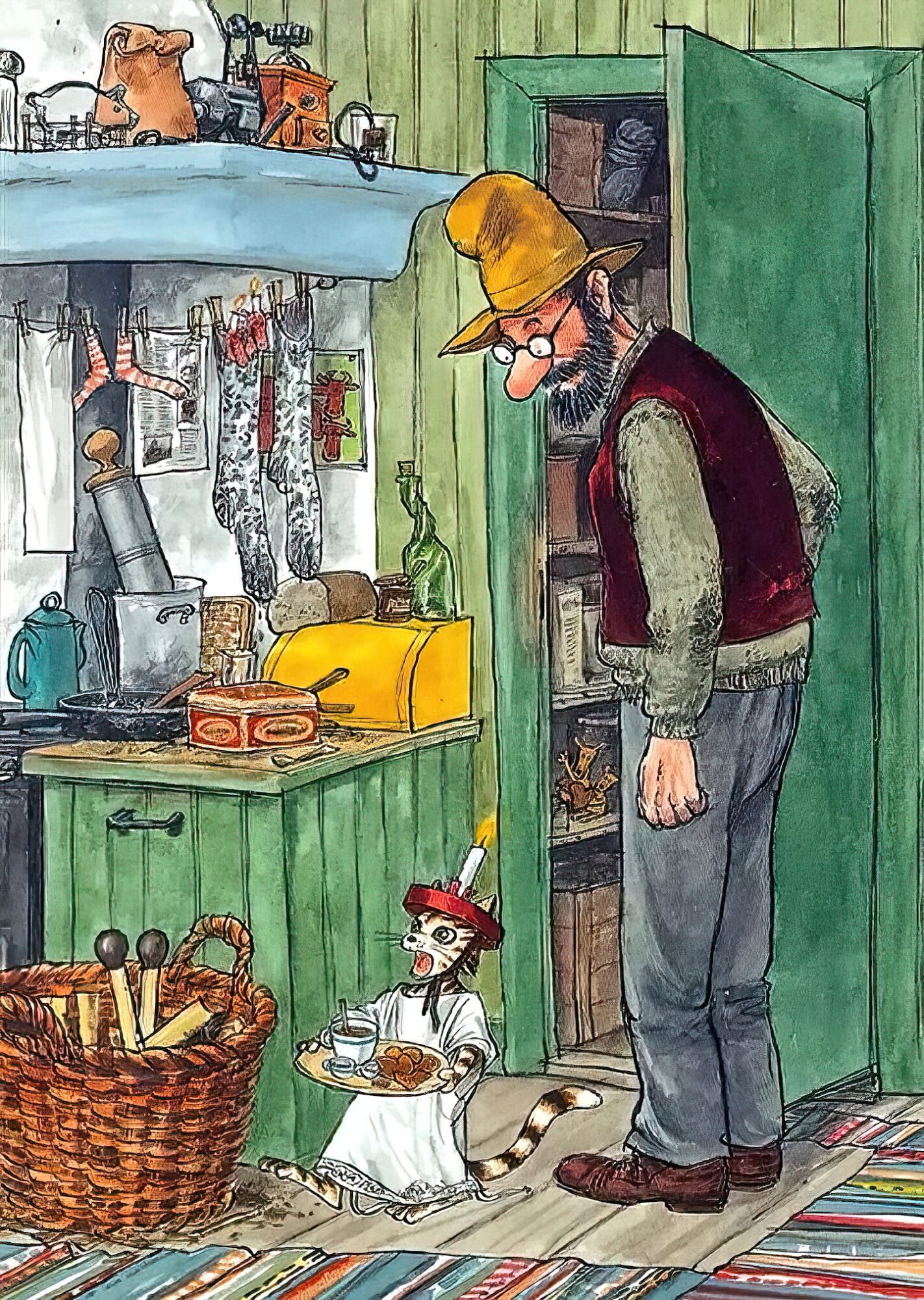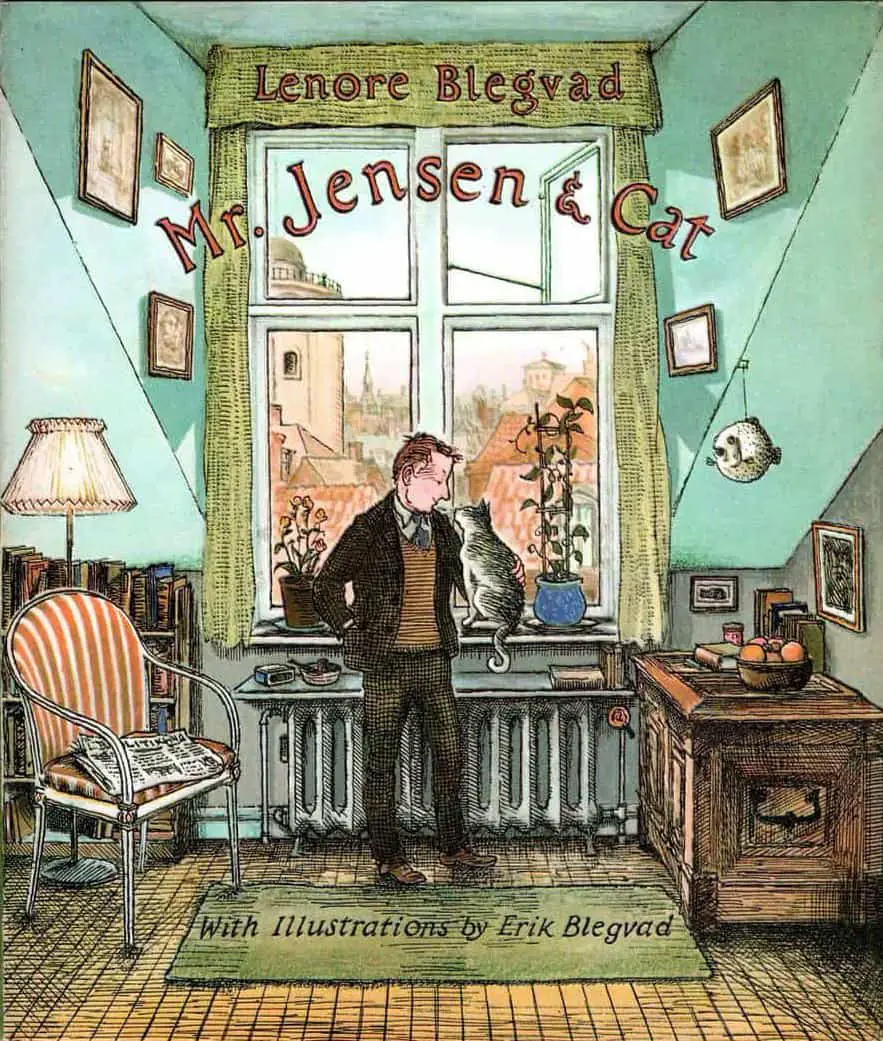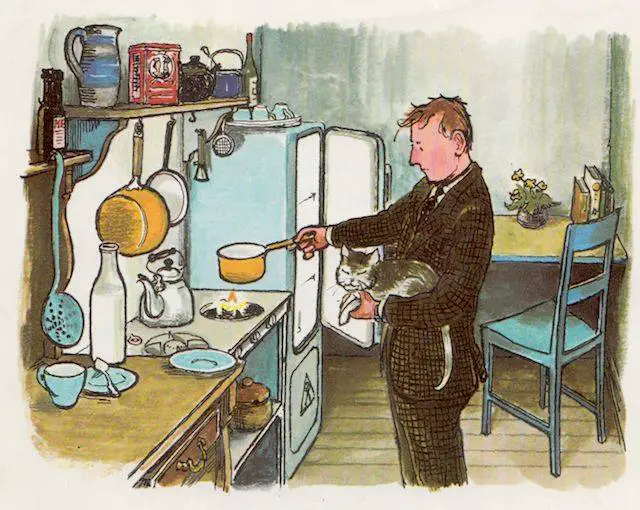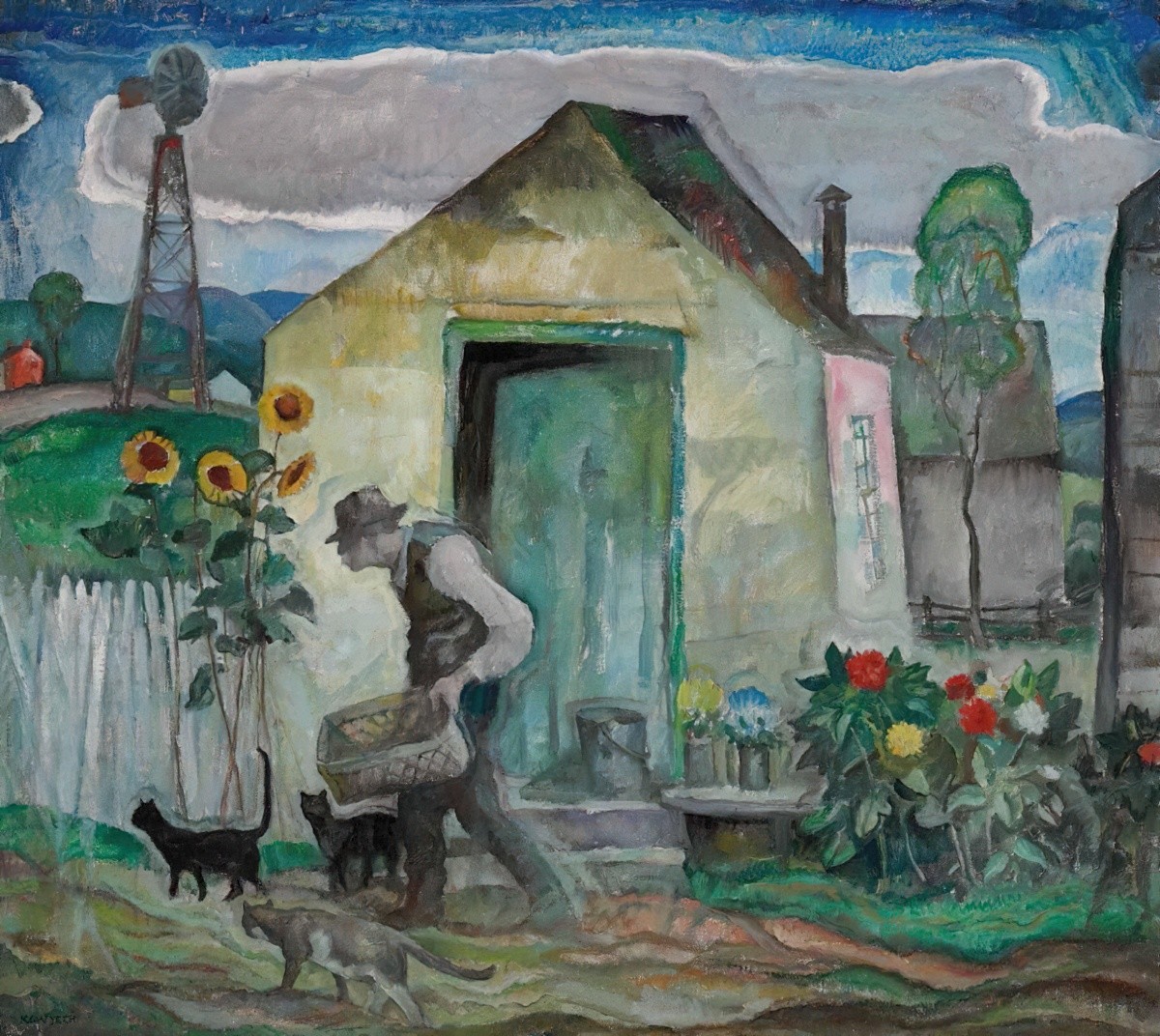Pancake Pie (1984) is a Swedish picture book written and illustrated by Sven Nordqvist, and is the first in the Pettson and Findus series starring a man and his cat who live together on a rustic farm, along with many little creatures who make the setting seem alive.
What is a pancake pie? Is it just… a pancake? I’m reminded of a certain song about a big pizza pie (actually just a pizza), which is much improved after the moray meme came out.
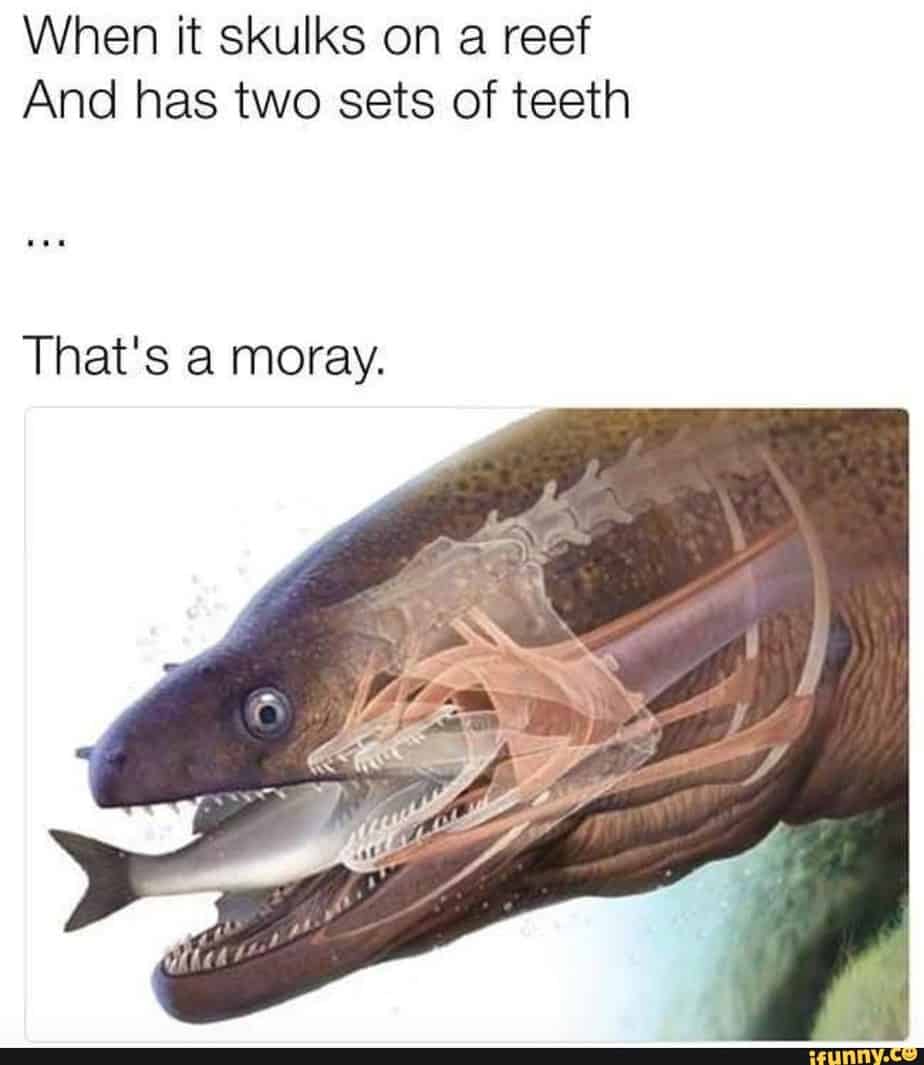
The Pettson and Findus books have been adapted for children’s TV. The Pancake Pie book became Pancake Pudding in the adaptation. I’ve not heard of a pancake pudding, but it does look more like a storybook cake, and I can see it works better on the screen. The storytellers don’t really want the audience to be stuck, as I am, on the question of what the food is. The food is not central to the story.
This is likely why Swedish Pannkakstårtan was first translated as Pancake Pie in 1985 but later as The Birthday Cake in 1999
SETTING OF FINDUS AND PETTSON
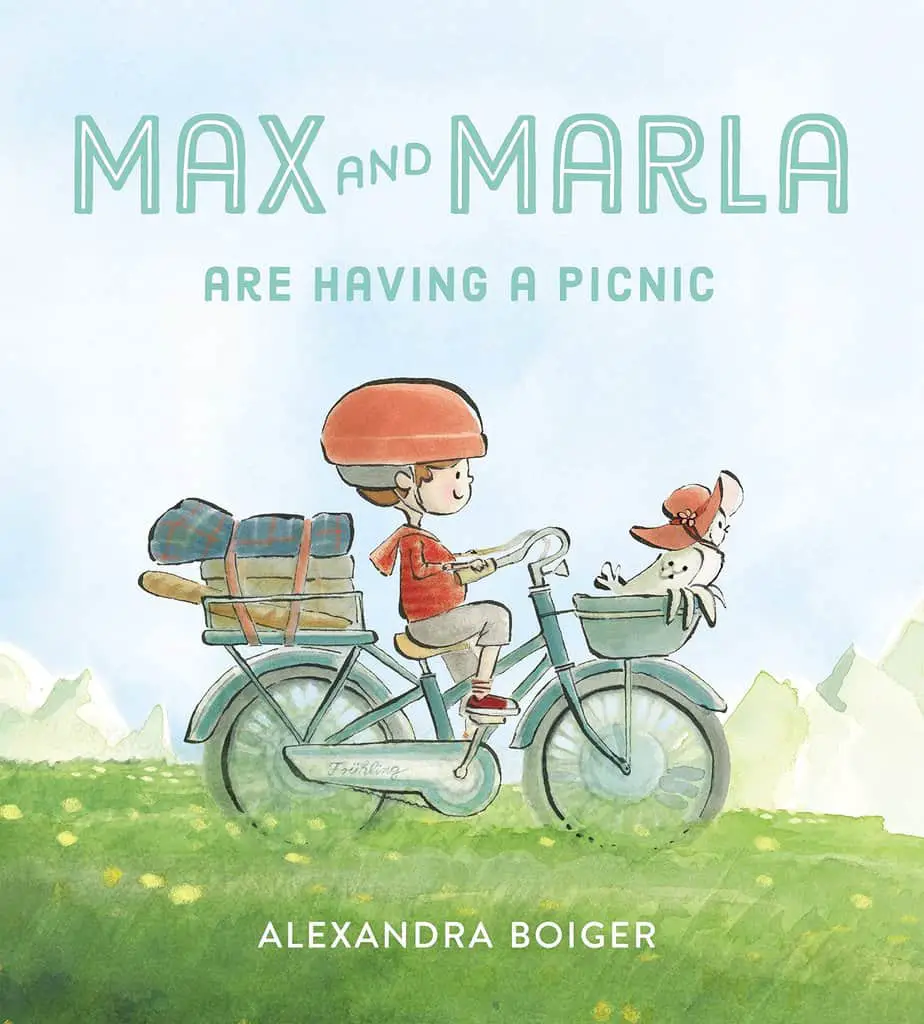
- PERIOD — Findus and Pettson live on a storybook farm which is clearly Scandinavian, if you are at all familiar with with a Scandinavian farm looks like, with the open rectangular arrangement of the farm buildings.
- DURATION — This particular story takes place over a day. It’s all done and dusted in time for a sit-down afternoon tea outside.
- LOCATION — rural Sweden
- ARENA — The whole story takes place between the farm and the nearby village where it is possible to buy anything you don’t have at home, in this case flour.
- MANMADE SPACES — The Swedish farm buildings, the village shops, the well (which looks unlike your archetypal storybook well — this one must be based on a Swedish well.
- NATURAL SETTINGS — pastures around the farm, hills in the distance
- WEATHER — The Pettson and Findus stories span all the seasons. Some of them take place when it’s snowing; this one happens in a temperate season, perhaps summer.
- TECHNOLOGY CRUCIAL TO THIS PARTICULAR STORY — Pettson’s bicycle is important to his characterisation. I really love this guy, with his pedal power and his cat. If he drove a car he’d be a different sort of guy altogether.
- LEVEL OF CONFLICT — In the hierarchy of human struggles, this is an unlikely, fantasy, carnivalesque struggle in which the goal is simple; to bake a birthday cake. It’s not even a high stakes birthday given that the birthday person celebrates birthdays three times a year, just because.
- THE EMOTIONAL LANDSCAPE — In the TV adaptation, Findus is annoyed that Pettson seems to have forgotten one of his superfluous birthdays. This story is also about how annoying things happen and there’s no point apportioning blame for these things. Rather, we have no choice but to get on and deal with them if we want to achieve our goal.
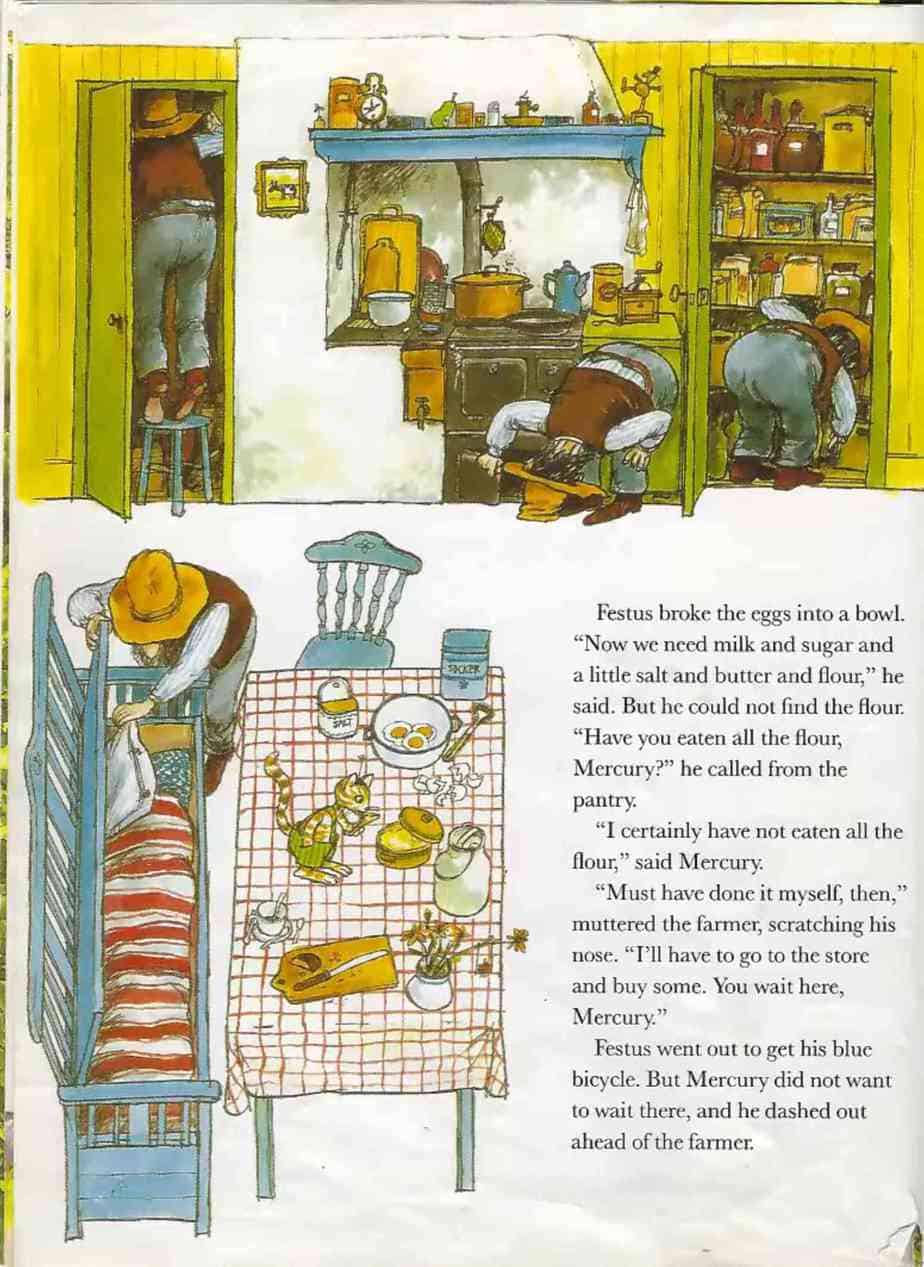
STORY STRUCTURE OF PANCAKE PIE
PARATEXT
Translators over the years have had a bit of a job deciding on how to translate this series into English. The paper below makes for an interesting case study into how publishers try something then later change their minds.
From Pettson and Findus to Festus and Mercury… and Back Again: A Comparison of Four Translations of Sven Nordqvist’s Picture Books
The book title Pancake Pie is also translated as Pancakes For Findus (which I admit makes more sense). The title is probably modelled on Blueberries for Sal by Robert McClusky.
Pancakes for Findus is the first story in the adventures of farmer Pettson and his cat Findus. Pettson wants to bake a birthday cake for Findus, who has three birthdays a year. But how will they get the eggs with the bull in the way?
marketing copy
Findus and Pettson live in a ramshackle cottage in the country, with a henhouse, workshop, and woodshed. Their fascinating, magical world is inhabited by tiny creatures who move Pettson’s things about when he isn’t looking.
SHORTCOMING
We know from other books in the series that Pettson is probably a widower and his neighbours find him a little odd. The cat comes across to the reader like a proxy child. For storytelling purposes we can consider Findus a child ranging between the ages of 5 and 10, depending on what the situation calls for.
Pettson wears glasses as part of his character design. This shows how he is oblivious to the small creatures around him who are alive. Another character with the exact same trope is Muriel of Courage the Cowardly Dog. In both cases the pet can see all the opponents but the human occupant sees nothing. In Muriel’s case she fails to see some pretty dire baddies, but the setting of the Pettson and Findus stories is more utopian. The creatures are mischievous and sometimes cranky, but never evil.
The co-star Findus has all the shortcomings typical of a small child, and as in any comedic series, he never grows up. He continues to be self-centred and petulent, in a lovable way. I I find the TV version of Findus unlikeable, and I think it’s mainly to do with the English dub of his voice, which is irritating. Voicing animals is always difficult.
Another example of this exact difficulty: ‘Dog’ of Footrot Flats by Murray Ball. New Zealanders were already in love with Dog from the newspaper comic strips, and the makers of the 1980s Footrot Flats film had a hell of a time settling on how Dog’s voice should sound. I have a Border collie myself these days and I think they got it right.
The creators of the 1980s Garfield animations also got Garfield right, but as a kid I didn’t think so. I was shocked to find that Garfield had a lazy adult male voice when I had expected something more like… the Findus voice. More ‘miowy’, more aimed at kids. Now I’m an adult I can see Garfield’s voice is correct, and that as a kid I had been far too generous in my interpretation of that cat’s character.
DESIRE
Self-centred Findus wants three birthdays per year and Pettson wants to oblige his cat. However, this kind of self-absorption is only briefly critiqued, and only in the TV adaptation, in which a hen clucks at the extravagance of three birthdays per year. The young reader is not encouraged to side with the judgy hen though, so the idea of three birthdays per year is a carnivalesque bit of fun and also wish fulfilment. What kid wouldn’t want three birthdays per year?
On a deeper level, Findus wants to be the centre of attention with luxuries foisted upon him.
On the most surface level, Pettson and Findus want to celebrate the day by baking something and eating it as a treat, whether we call it a pancake pie or a pancake pudding or whatever.
OPPONENT
The storyworld itself stands between Pettson getting flour, or not. But ‘things going wrong in the world’ doesn’t usually make for a satisfying opposition, so literally populating the arena with tiny creatures, each with their own agenda, is a masterful way to make a setting come alive. Pettson doesn’t simply get a hole in his bicycle tyre; a little creature bites a hole in it.
This is literally how people of yore saw the world. We only need look into earlier versions of fairytales such as The Elves and the Shoemaker to know this. That tale’s reason for existence is to warn people against fraternising with small creatures and spirits in the home, so clearly many people thought they actually existed!
We might as well consider these little creatures fairies. They don’t look like the 21st century conception of a fairy — small, butterfly-like femme coded creatures influenced by Disney’s Tinkerbell. Fairies can refer to any creature who lives in the world around us, and in our living spaces. Earlier humans imagined fairies absolutely everywhere. (Modern audiences get the feeling we now understand Earth and seem more concerned with populating space… we call them aliens though, not fairies.)
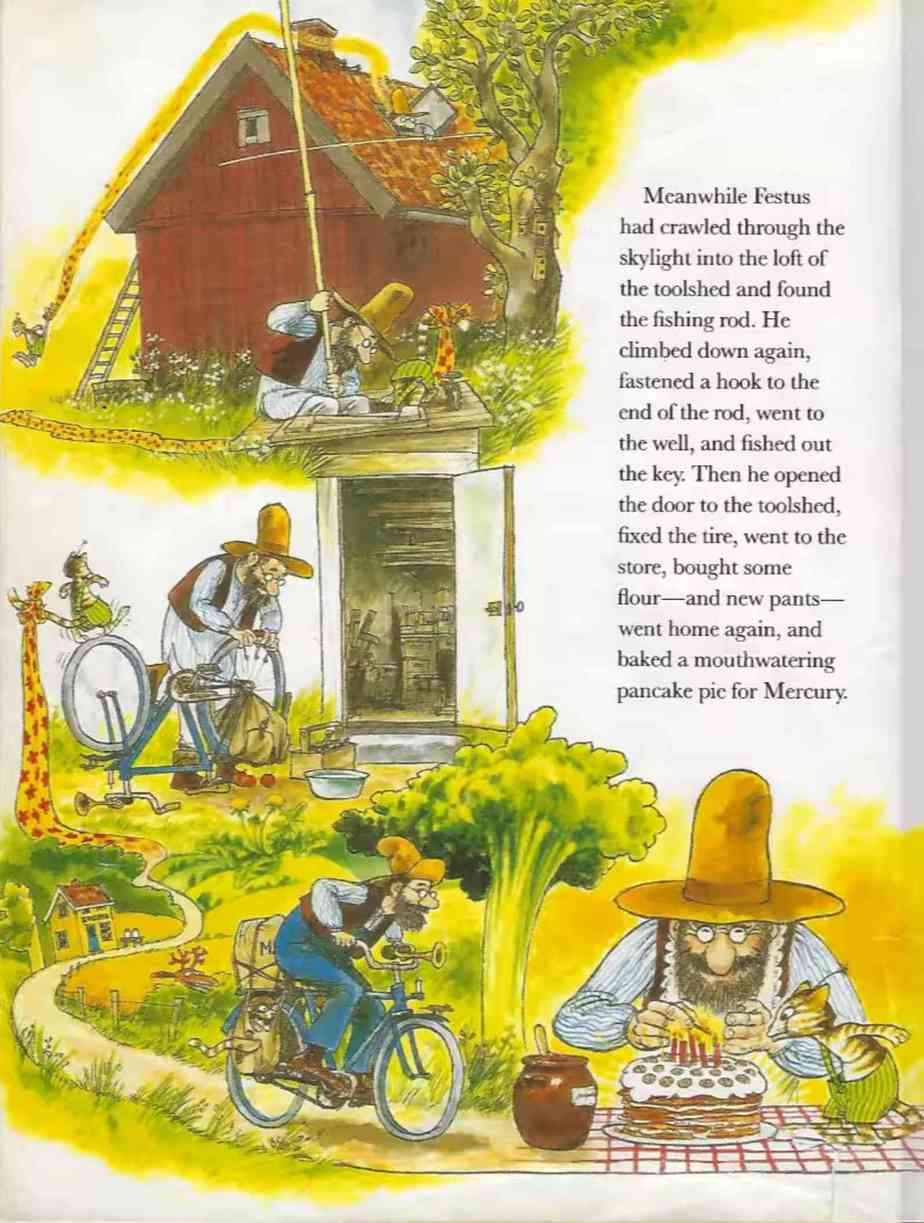
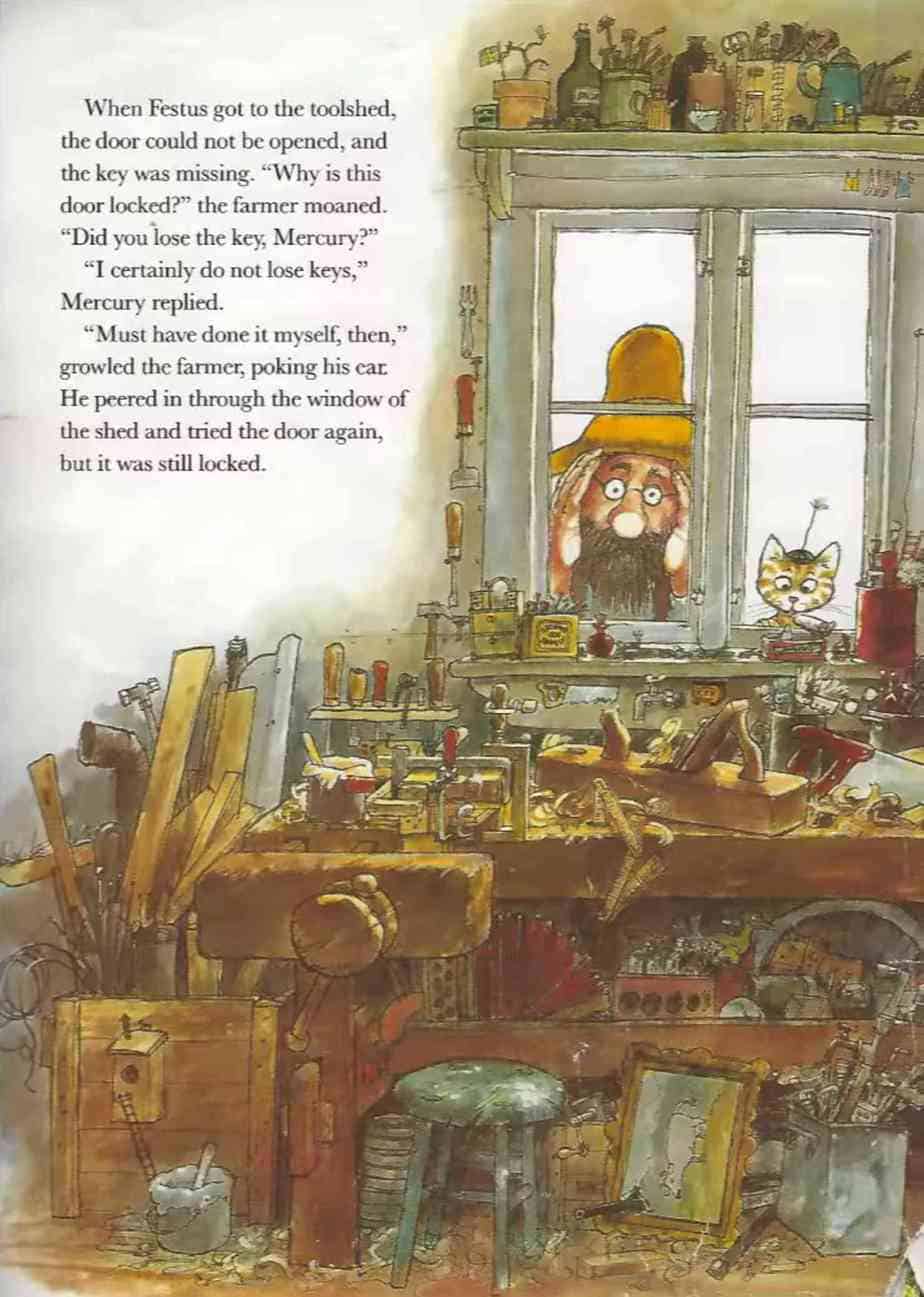
The neighbour who ambles by right as Pettson is washing his pants in a bucket also functions as an ‘observer opponent’. I’ve seen these scenes in other children’s stories, recently in Bluey, in which the father is playing a ridiculous game with his daughter when a dressed-up judgy poodle walks by and drags him with side-eye. She hasn’t got the memo that this small snippet is part of a game.
Audiences seem to love this gag — in which a main character is caught in the most humiliating part of a plot when someone happens to amble by. A funny moment now becomes comedically humiliating with the addition of an intradiegetic audience member. Funny how that works.
In such scenes, is it not humiliating enough that we, the audience, are watching? No, not if the fourth wall remains intact. Also, we are in possession of the complete story. We know how the character got into that position. Humour derives from the fact that the passerby is in audience inferior position. The joke is sort of actually on them, for failing to understand the whole scenario.
PLAN
Pancake Pie is basically a There Was An Old Lady Who Swallowed A Fly cumulative plot, except for one major difference: In the fly story, the old lady’s self-formulated plan is ridiculous. She herself is ridiculous. Perhaps for this reason I have never found that old lady an empathetic character. I couldn’t care less whether she lives or dies (and both endings exist in the world).
In the case of the empathetic Pettson, the scenarios are ridiculous (thanks to the fairies) but his plans are quite sensible, given the world of the story. Key falls down the well? Get a long stick and fish it out. Pants covered in egg? Take them off and wash them in a bucket.
It’s not Pettson who is eccentric; it’s his farm. Pettson is a misunderstood widower.
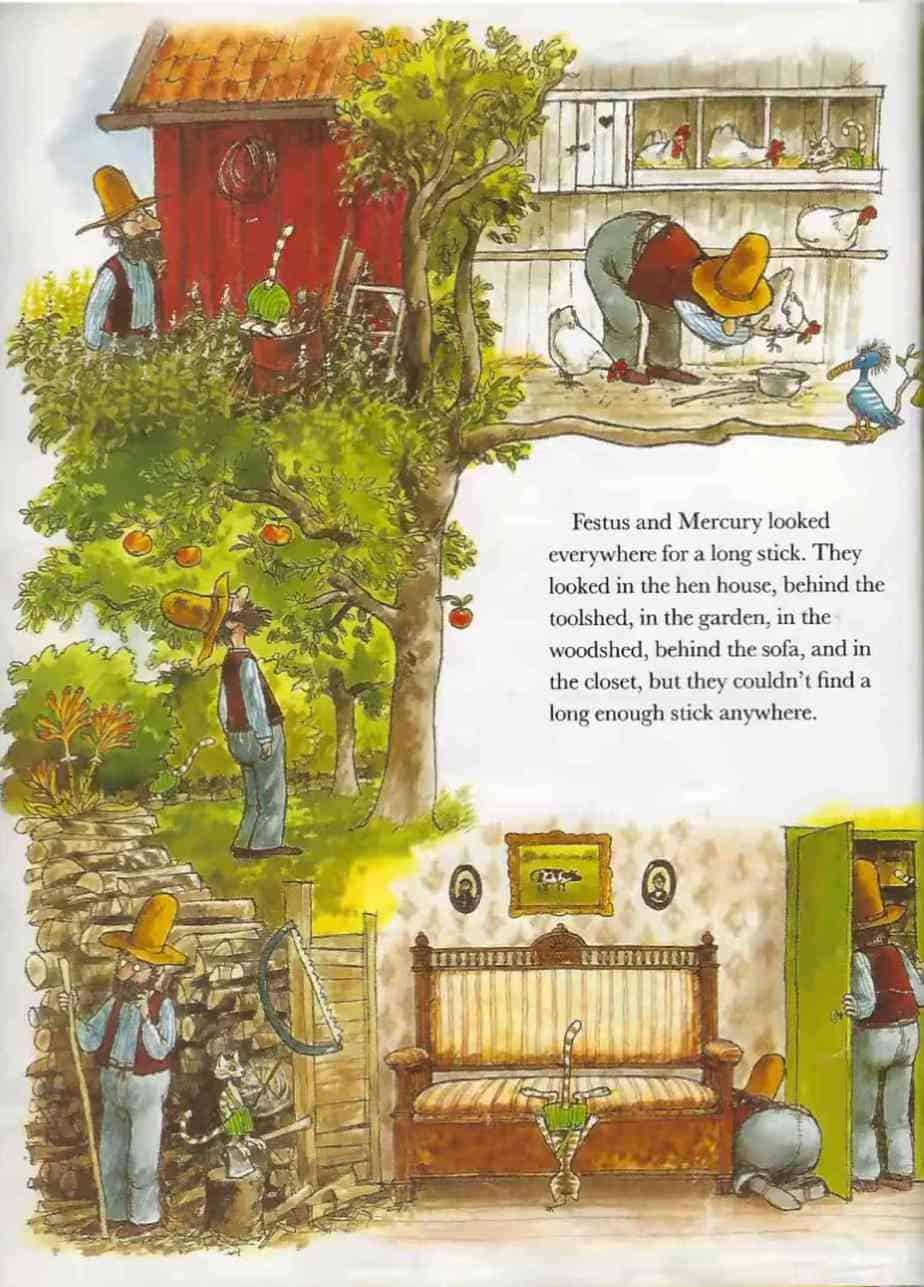
Honestly, I couldn’t follow the Plan part of the plot sequence on first reading. if you’d quizzed me immediately after for comprehension I would not have been able to tell you how Pettson goes from looking for flour to being chased by a bull in a field. But that doesn’t matter. We enjoy the spectacle and don’t mind the sequence.
That said, the sequence must make sense for the story to work, and it does if you’re paying attention, with a clear path from A to B to Z. Lucky for me, someone else wrote the sequence down in a humorous consumer review:
If Pettson, P, is to make a pancake pie, then P must buy flour.
If P is to buy flour, then P must cycle to town.
If P is to use a cycle C, then C’s tires must be intact.
If P is to make C’s tires intact, then P must obtain a cycle repair kit R.
If P is to obtain R, then P must have the key to the toolshed K.
If K is in the well W, then P must have a fishing rod F.
If F is on the roof, then P must have a ladder L.
If L is in the bull B’s field, then P must scare away B.
If P’s neighbor N had known all of the above, then N wouldn’t necessarily have thought P had lost his wits when he saw him playing Jussi Björling records for B on P’s wind-up phonograph.
That’s logic. What do they teach them in schools these days?
Goodreads
THE BIG STRUGGLE
This story might align more closely to the carnivalesque picture book story structure if it weren’t for the bull sequence.
The animals in this story span a broad section of the ‘animal-ness continuum’, with Findus basically human (a child), and the hens who are middle-aged gossipy women archetypes and also this bull who is nothing more than an actual bull.
The bull is a Minotaur opponent (more literally than most Minotaur opponents, which can come in any shape or form and most have nothing to do with actual bulls).
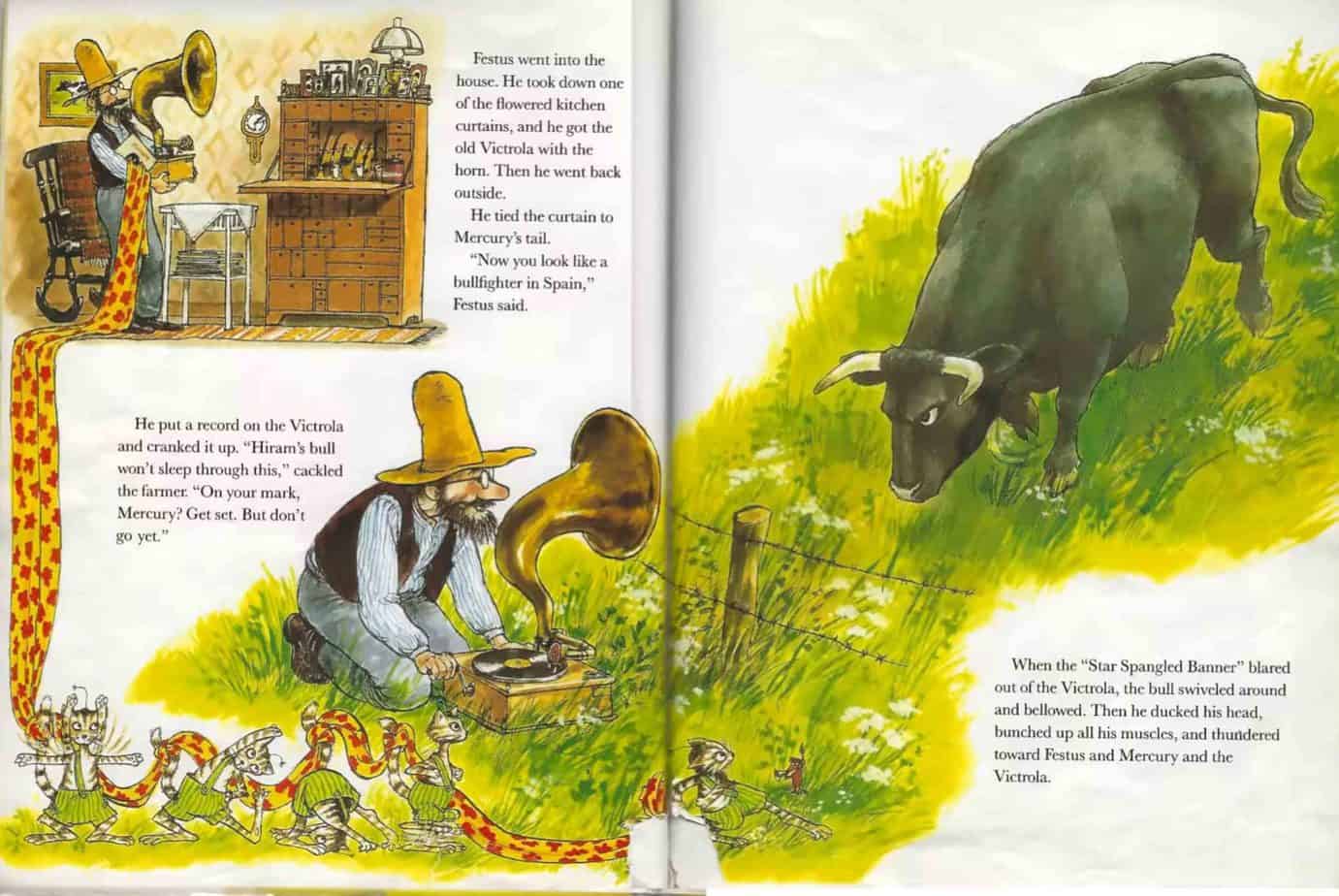
The story climaxes at the bull fight. Although the ridiculous events around baking a simple pancake pie build into something more and more ridiculous, the level of ridiculousness is not enough to ‘finish off the story’, which must be finished somehow. So Nordqvist ends it with an actual battle scene, complete with danger of death and a chase.
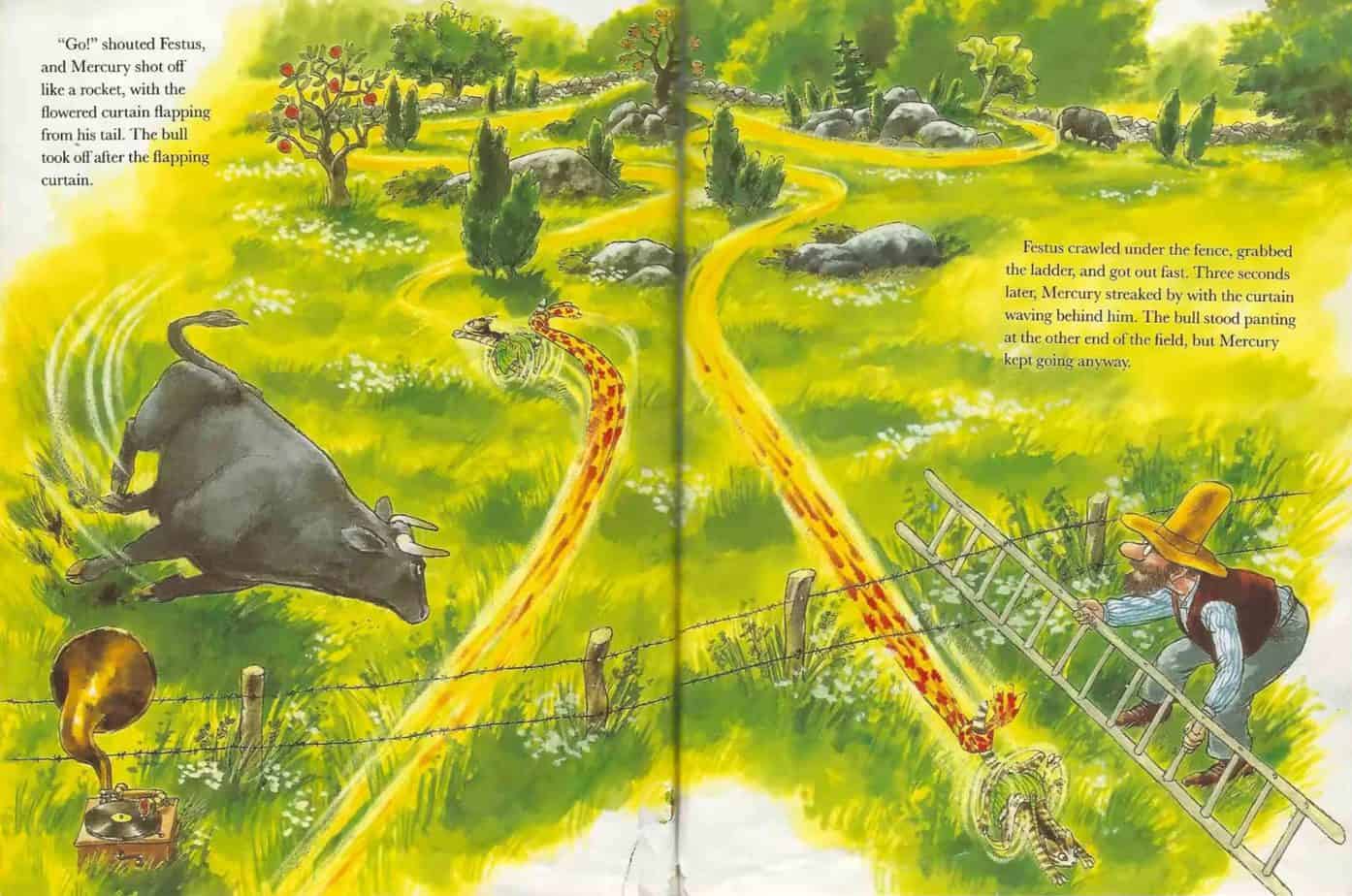
ANAGNORISIS
Findus and Pettson have no major epiphany, because this story was all about spectacle (for the reader). They realise that when they have their hands on the flour that they can sit down to enjoy an afternoon tea of pancake pie.
NEW SITUATION
Though the desire for food is mostly the McGuffin of this particular story, Pancake Pie is an excellent example of a children’s book where all is well when the main characters sit down to enjoy food. A number of series work like this, including the more recent Mercy Watson picture books by Kate DiCamillo and Chris Van Dusen. Those stories end when Mercy sits down with everyone to enjoy hot buttered toast.
Food is very important in children’s stories.
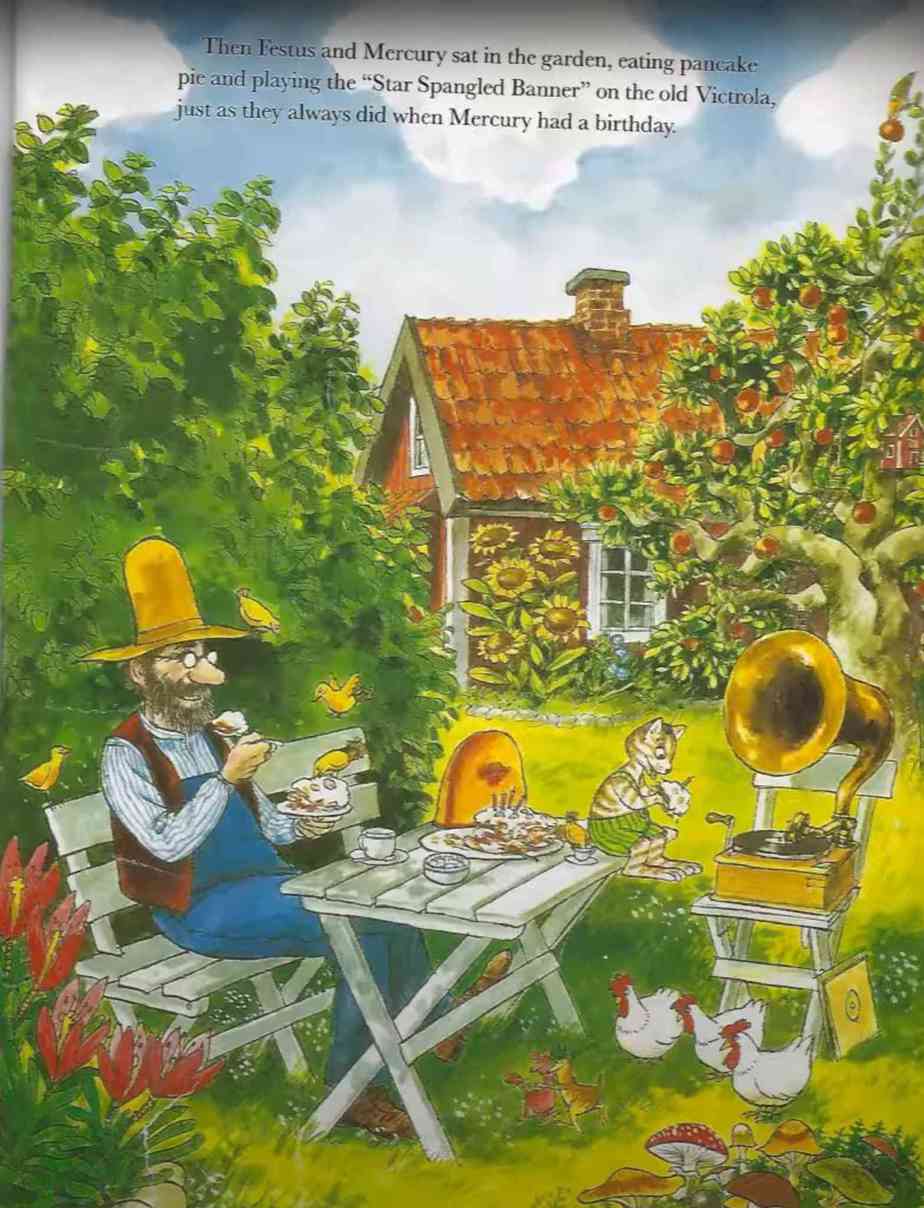
EXTRAPOLATED ENDING
Findus learns nothing. I fully expect him to wrap Pettson around his little dew claw in further stories of the same series.
RESONANCE
This story established the intriguing world of Pettson and Findus. I fell in love with Pettson immediately. For me the farmer is the sympathetic character, though for children I expect the cat will be relatable. In this way, the series achieves a dual audience.
Worlds populated by tiny creatures endure. The Pettson and Findus books were just a small part of that. The golden age of fairy and goblin stories may seem to have passed, but look at the Hilda series, recently adapted by Netflix, for a similar utopian world populated by tiny creatures who each have their own agenda but who pose no significant threat to the main, human characters.
PIES IN STORYTELLING
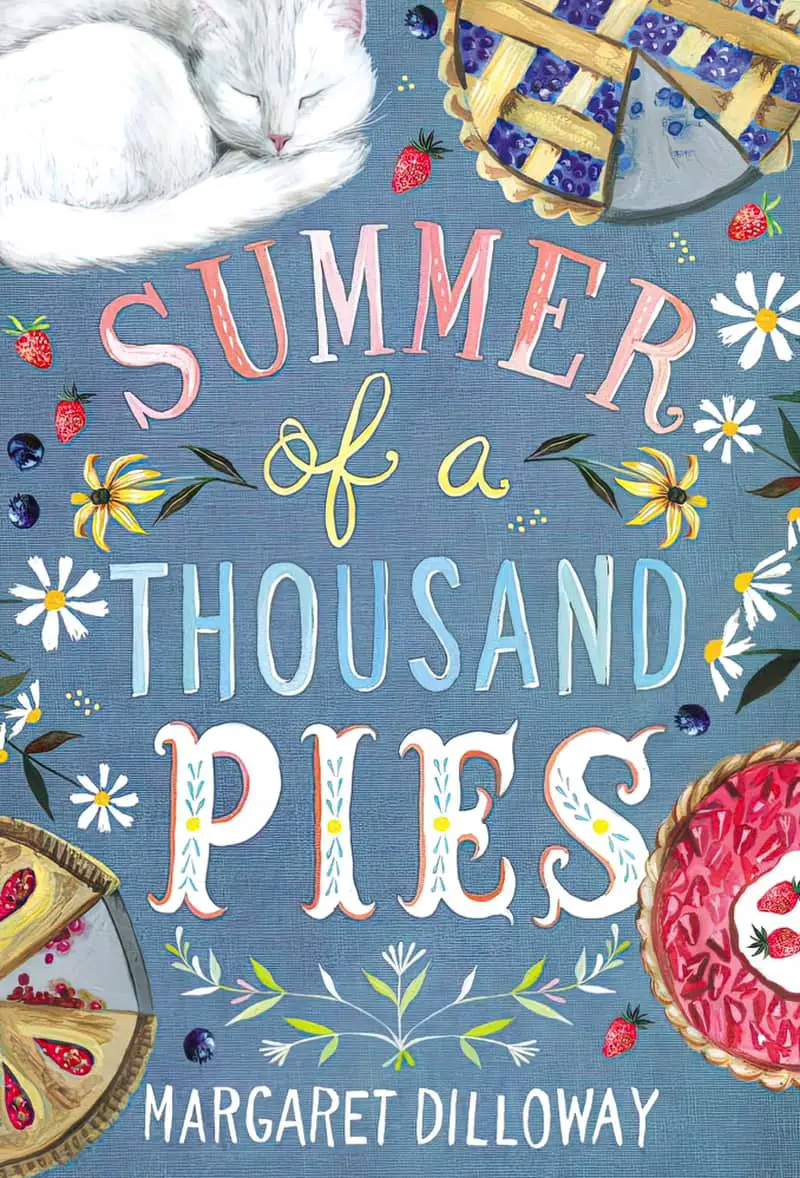
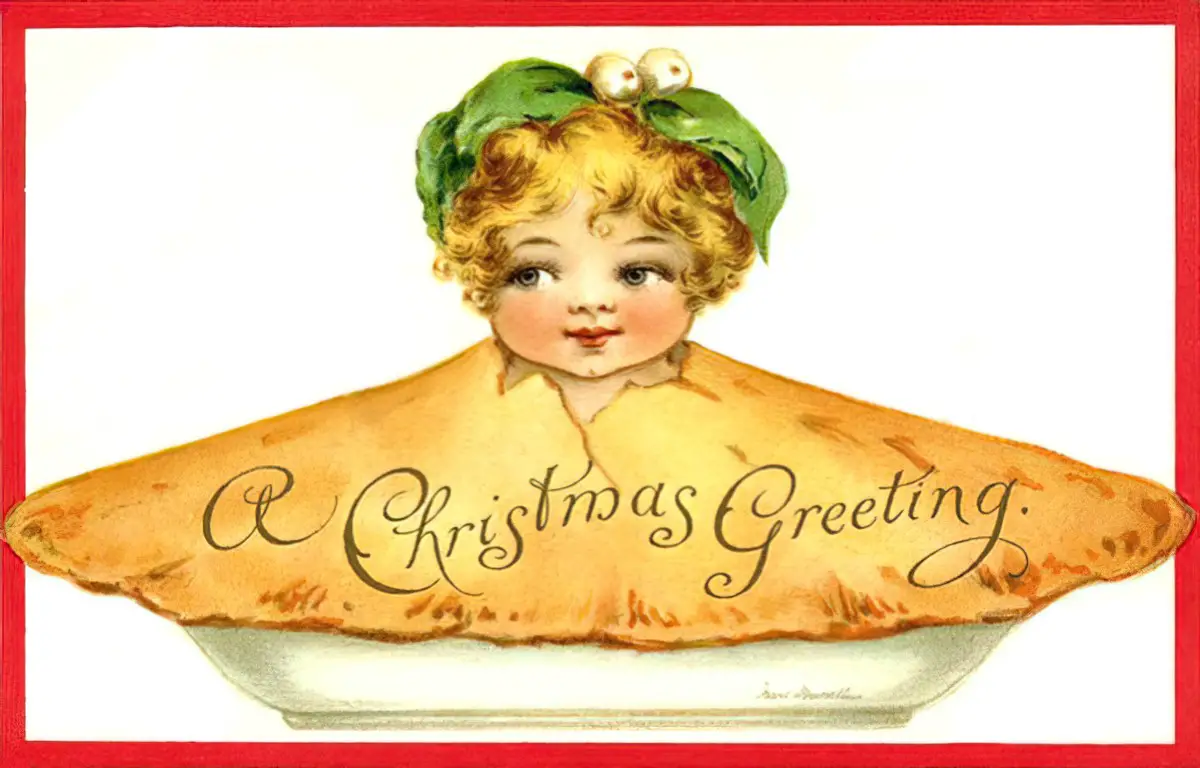
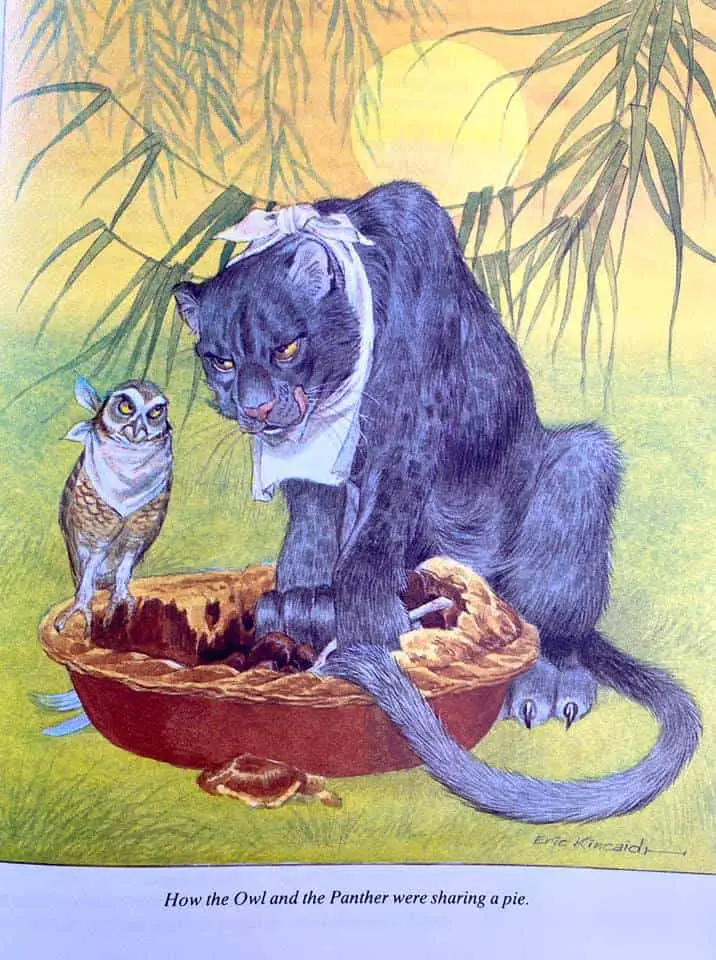
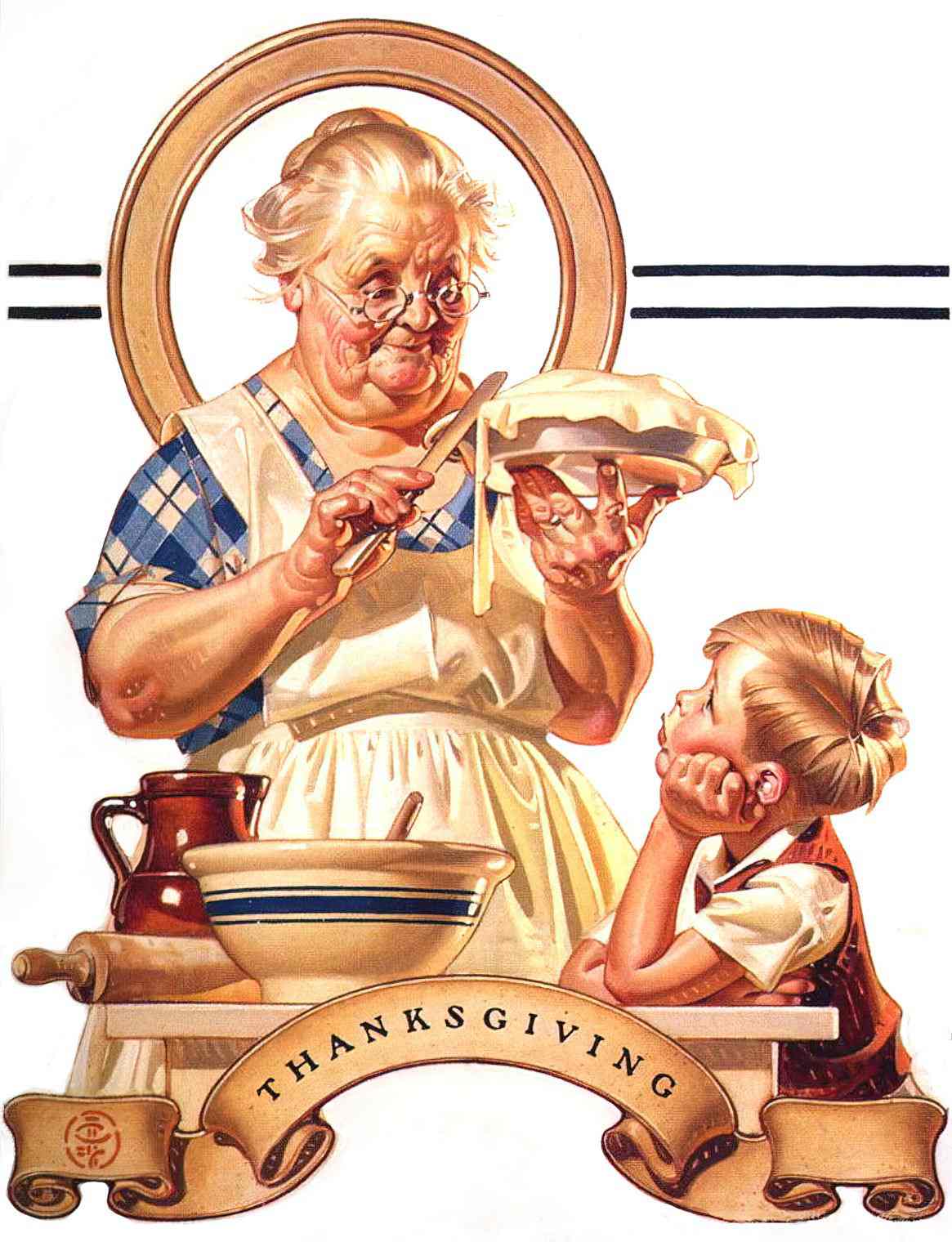
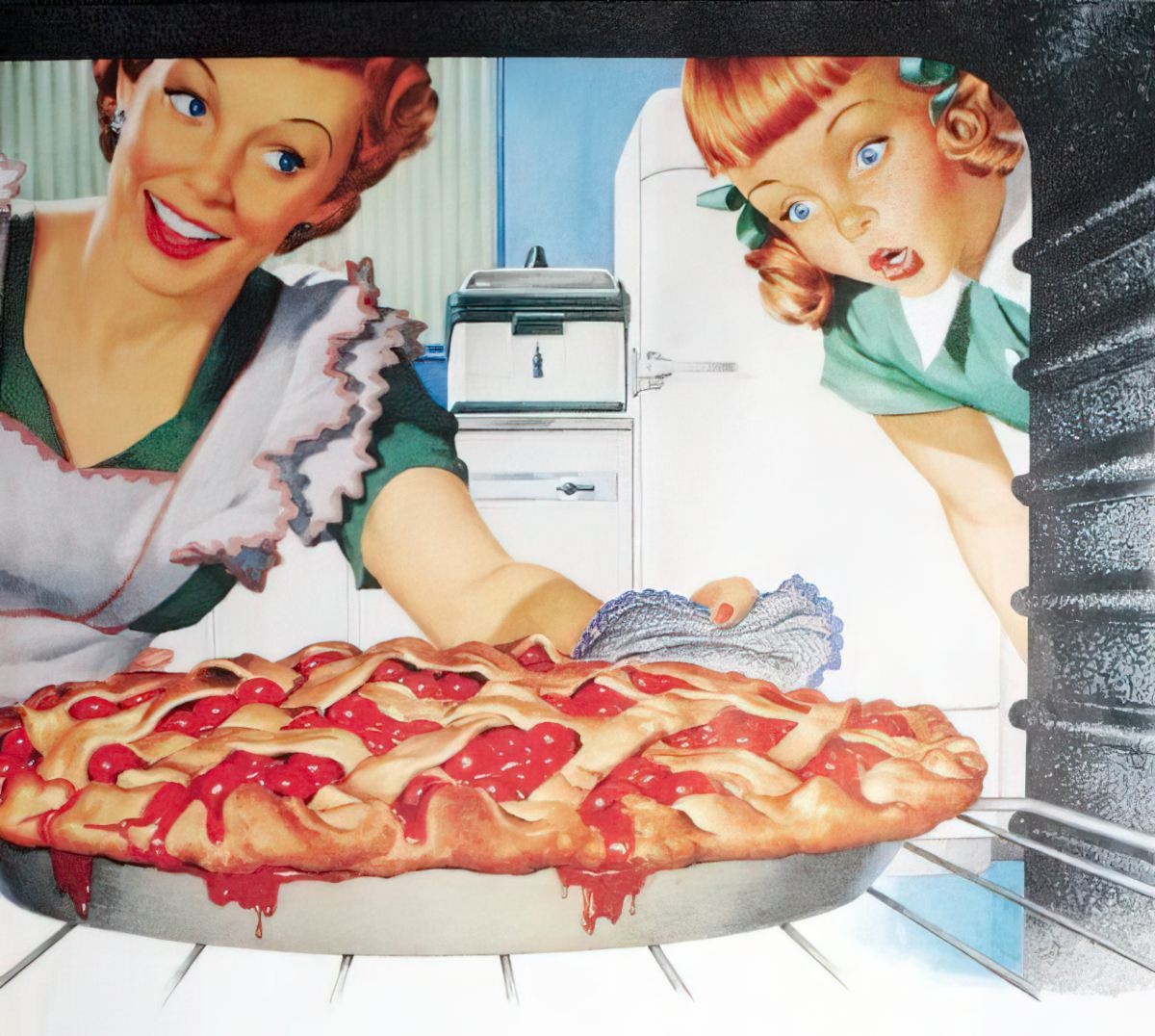
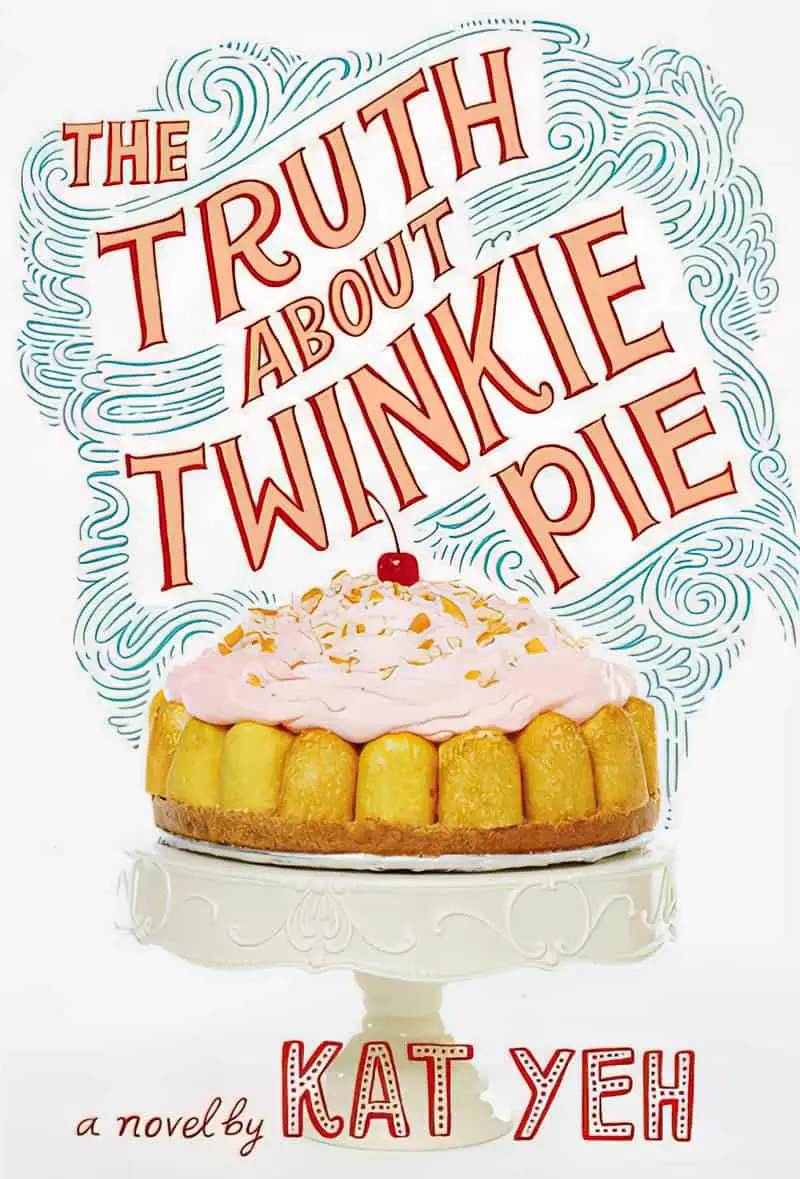
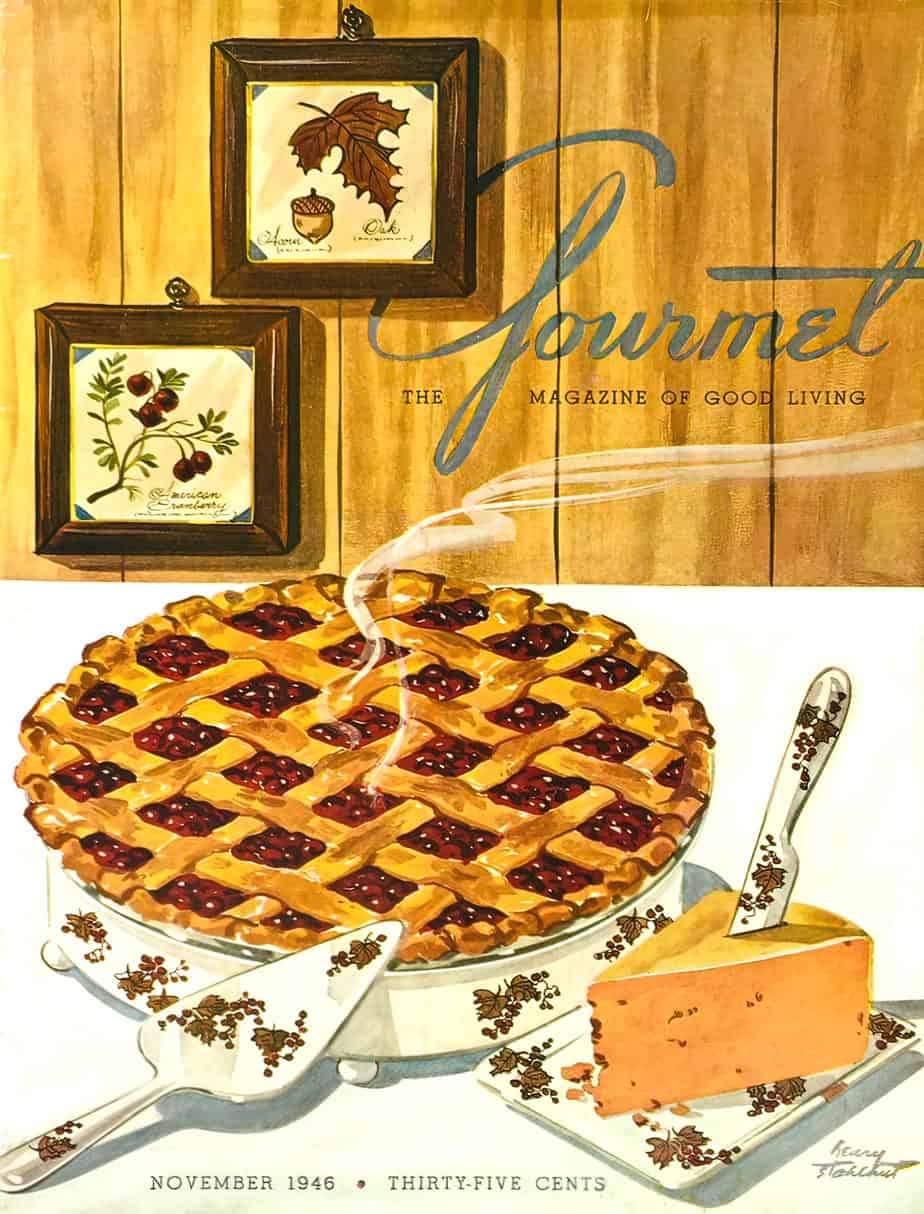
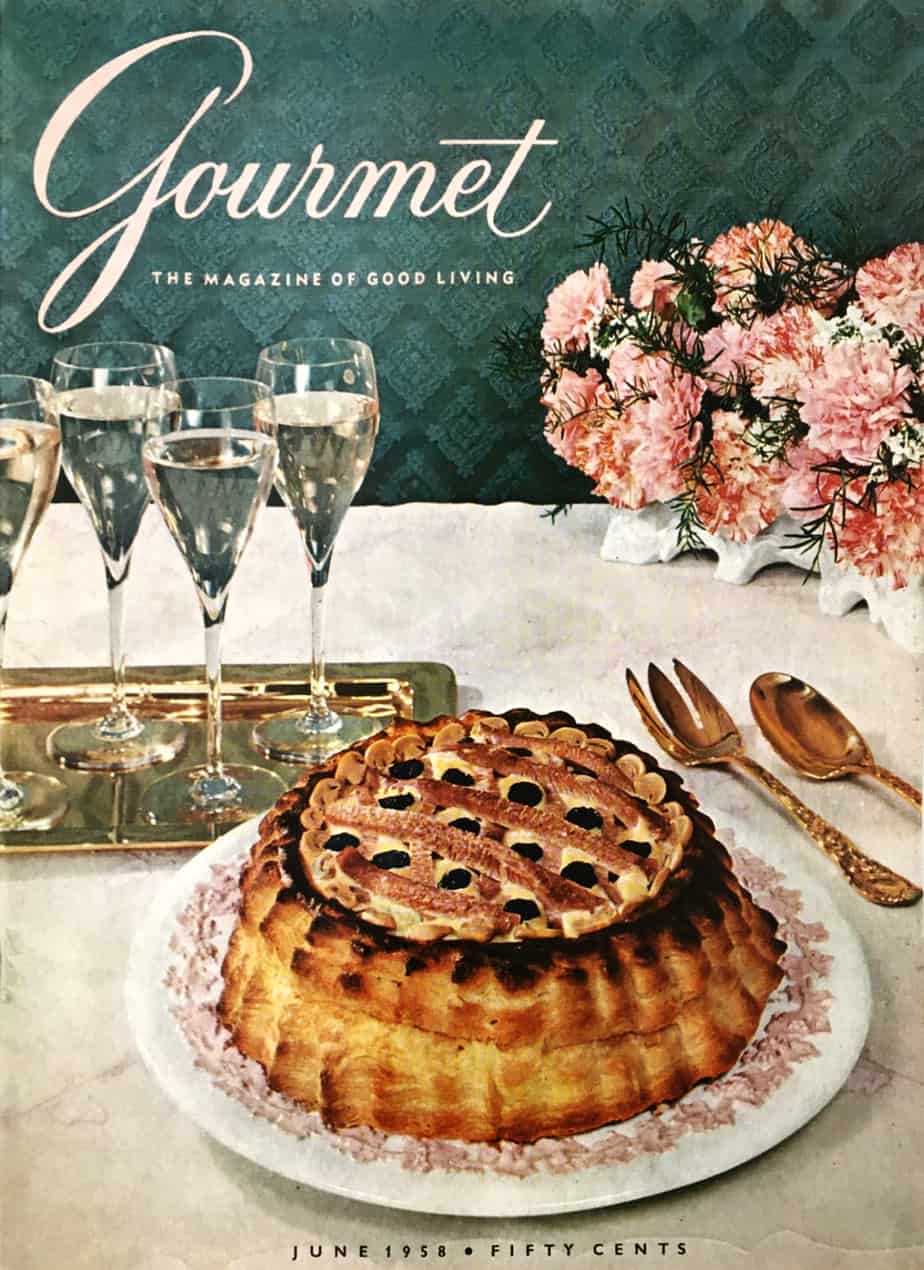
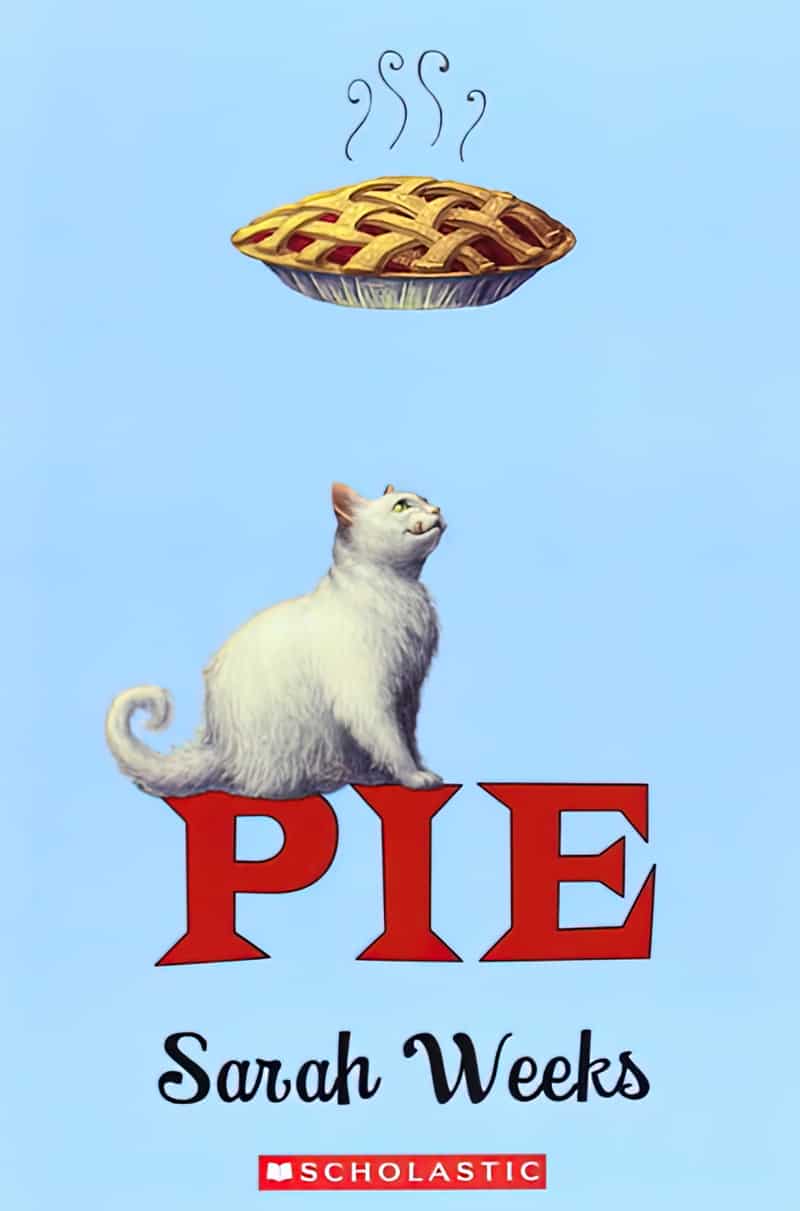
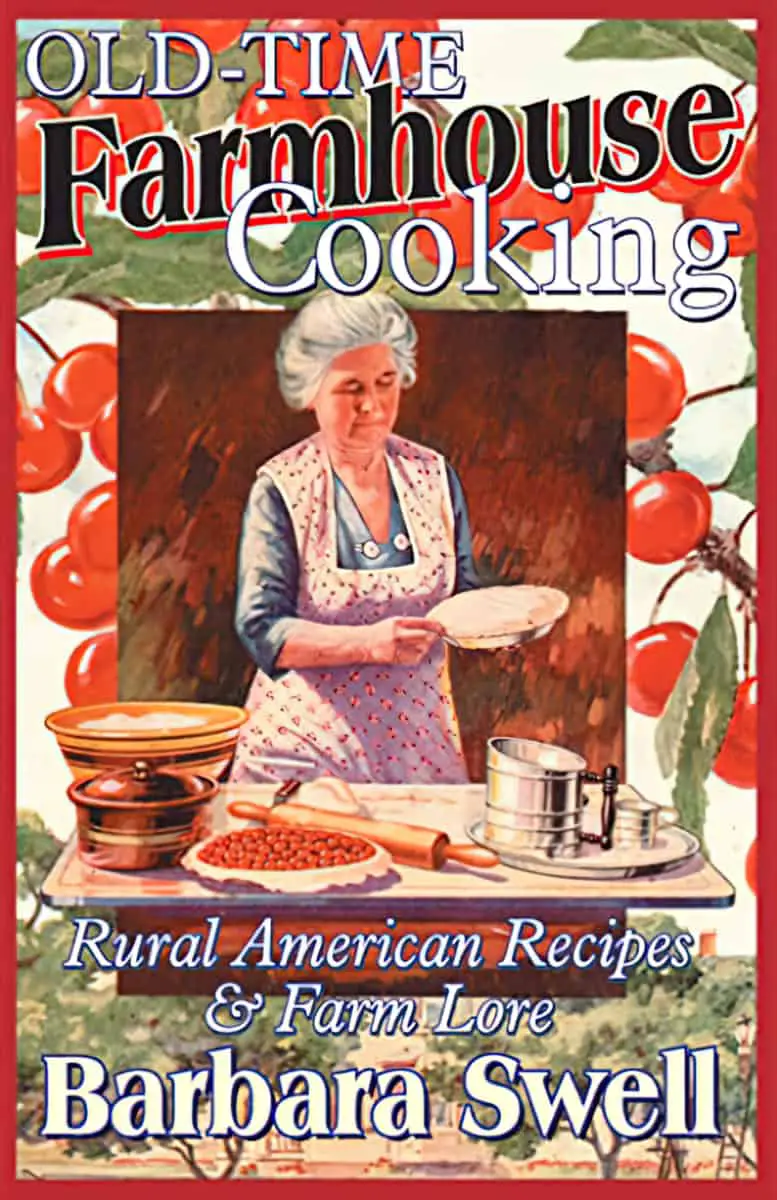
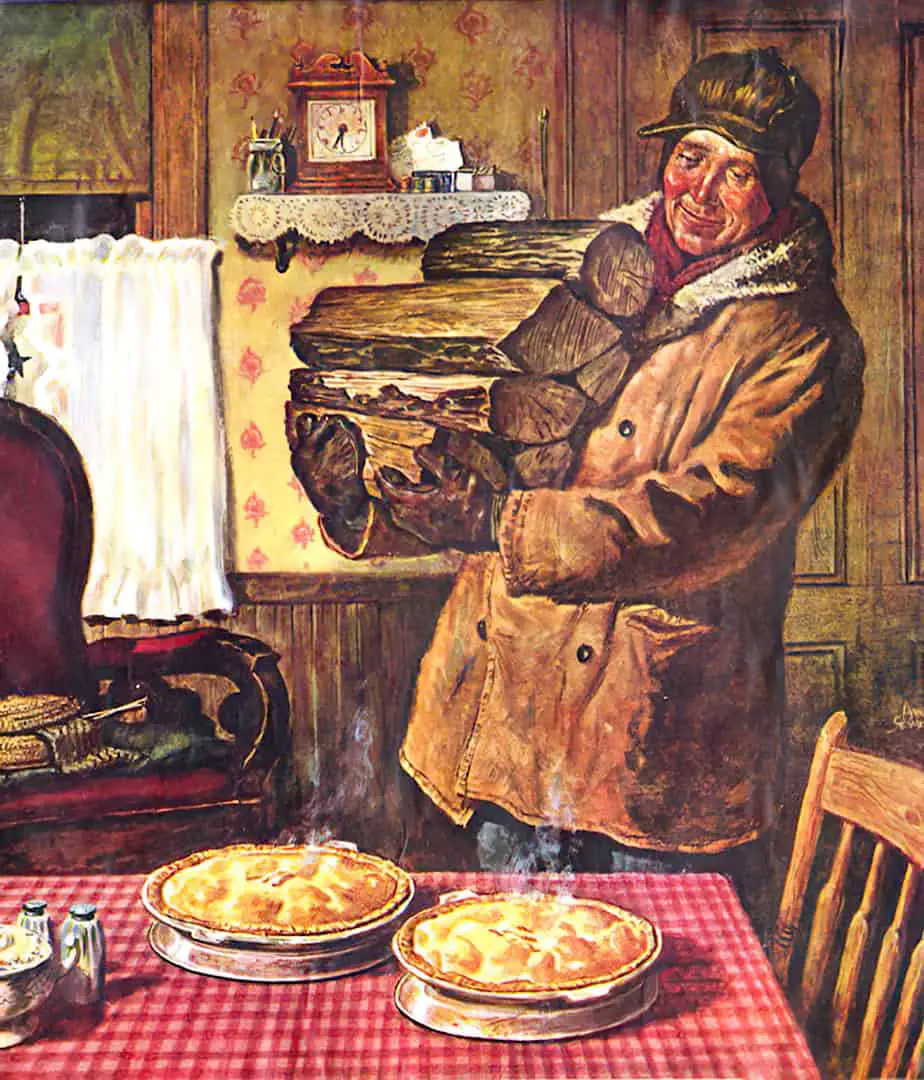
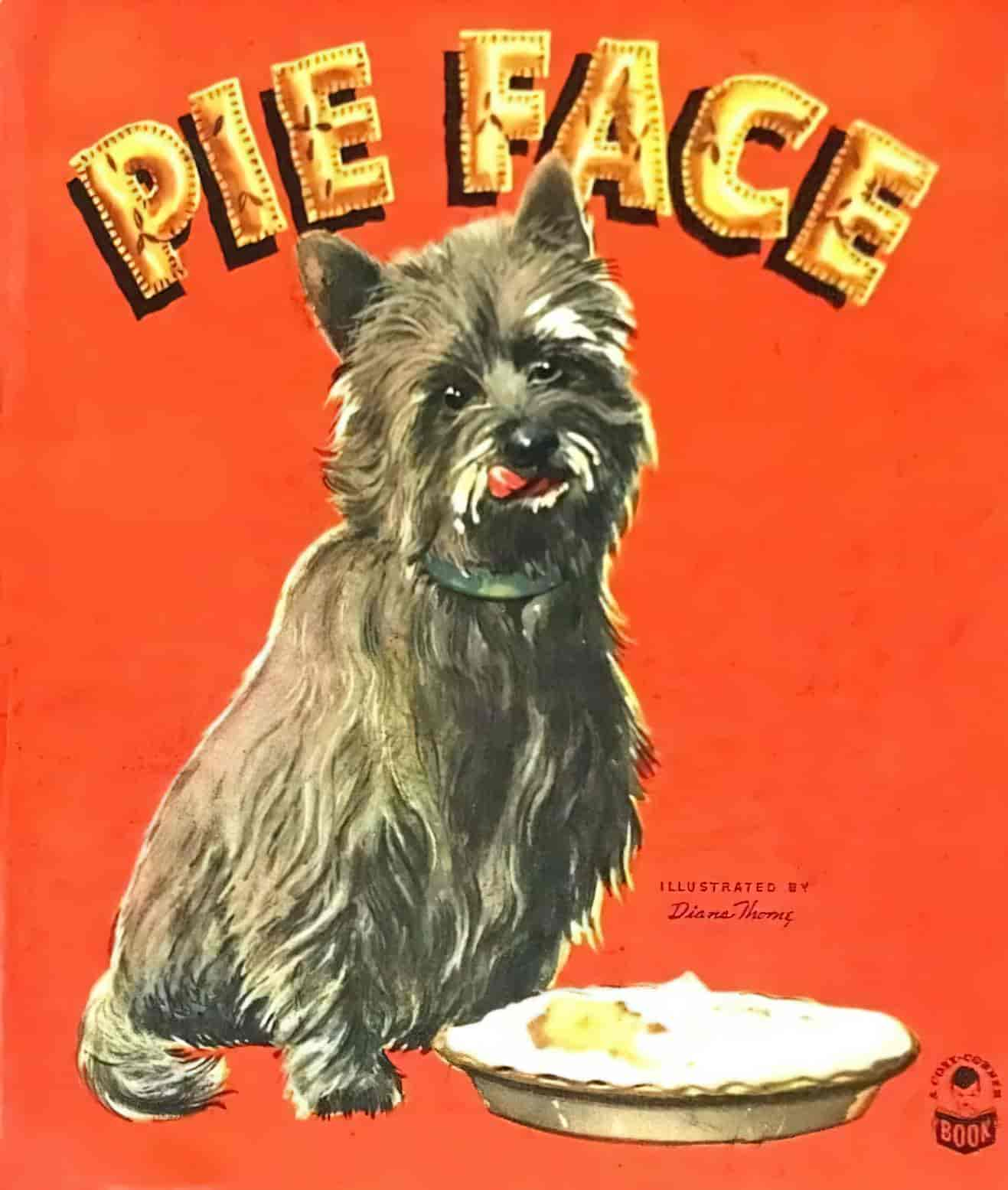
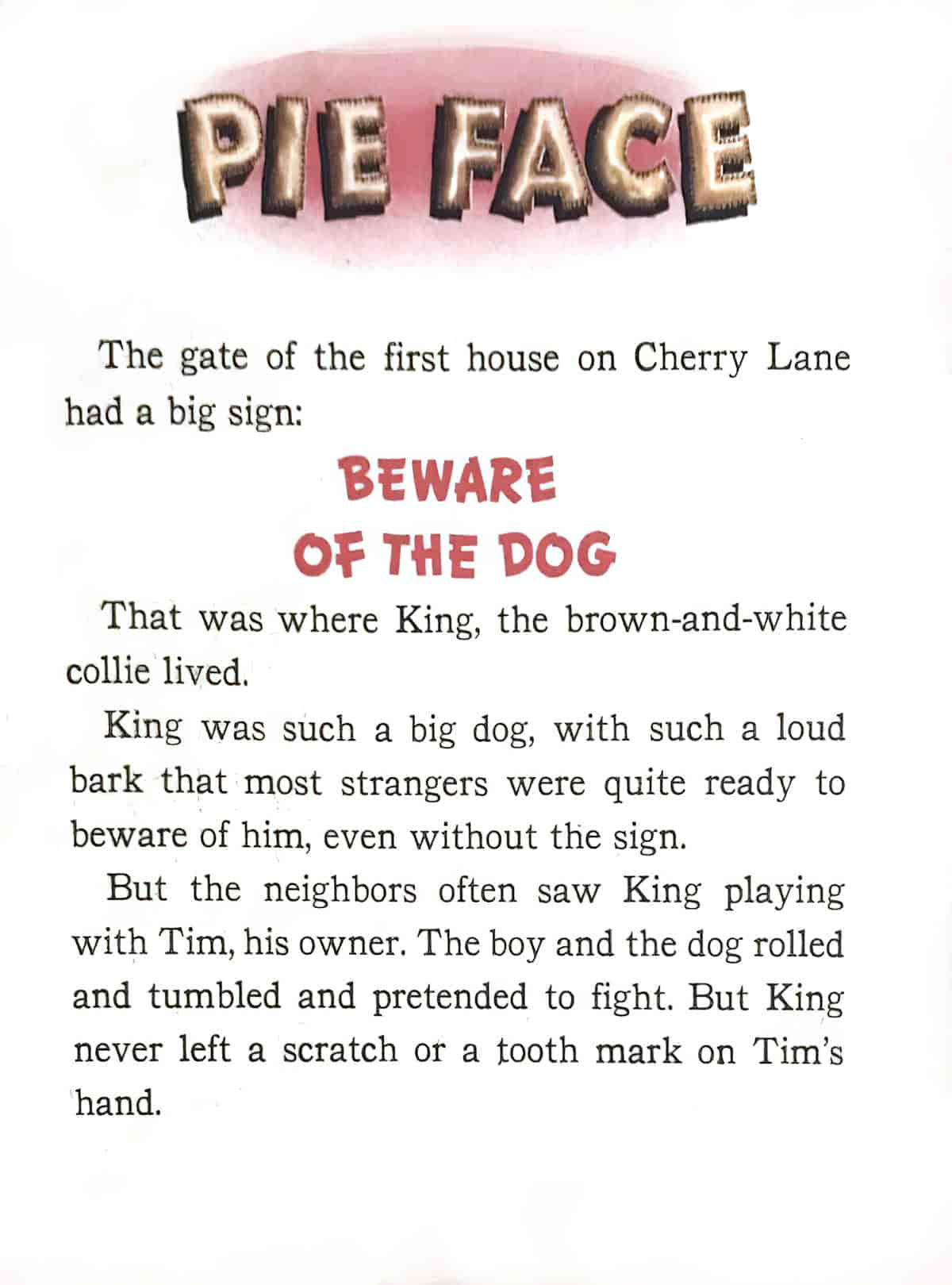
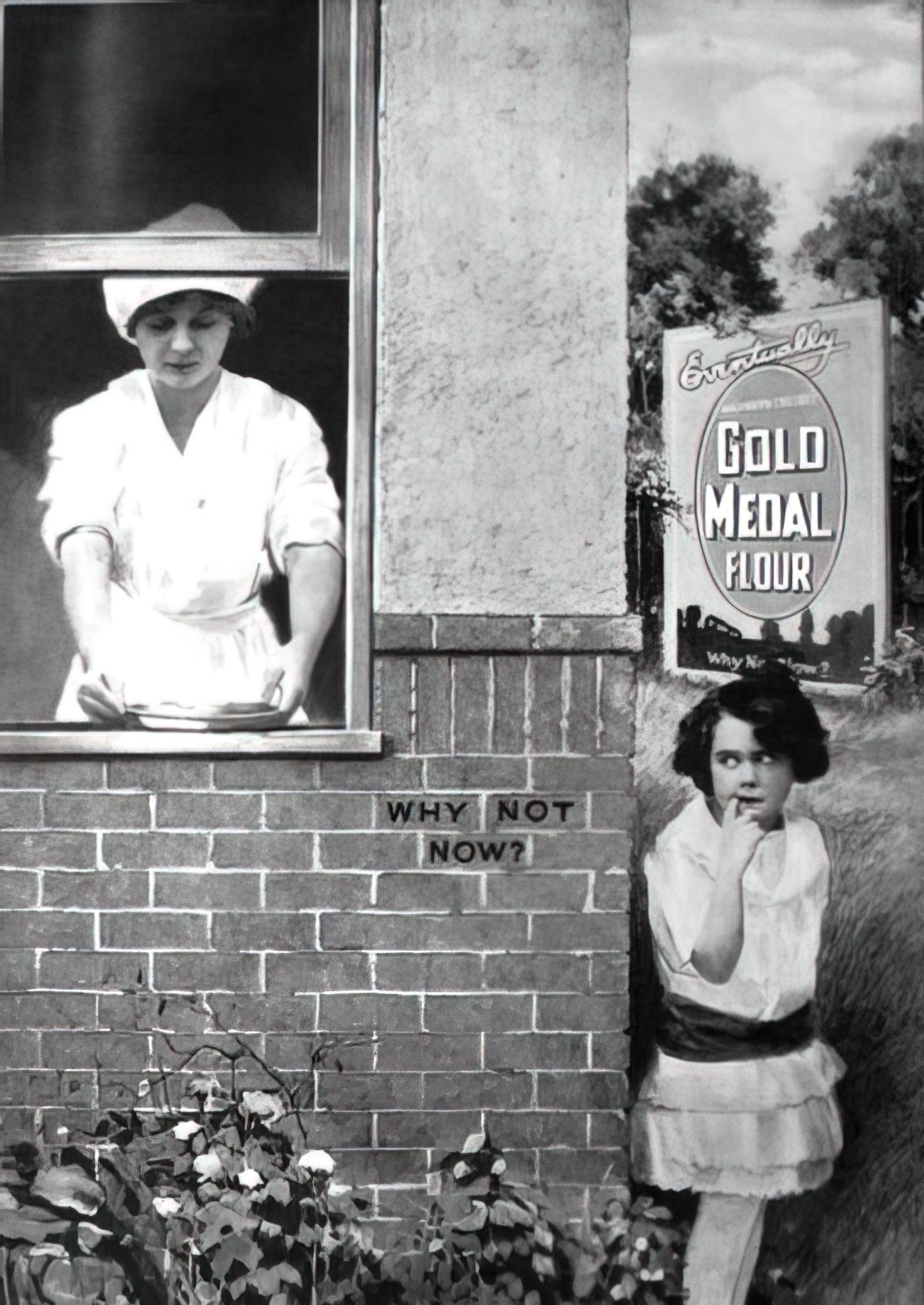
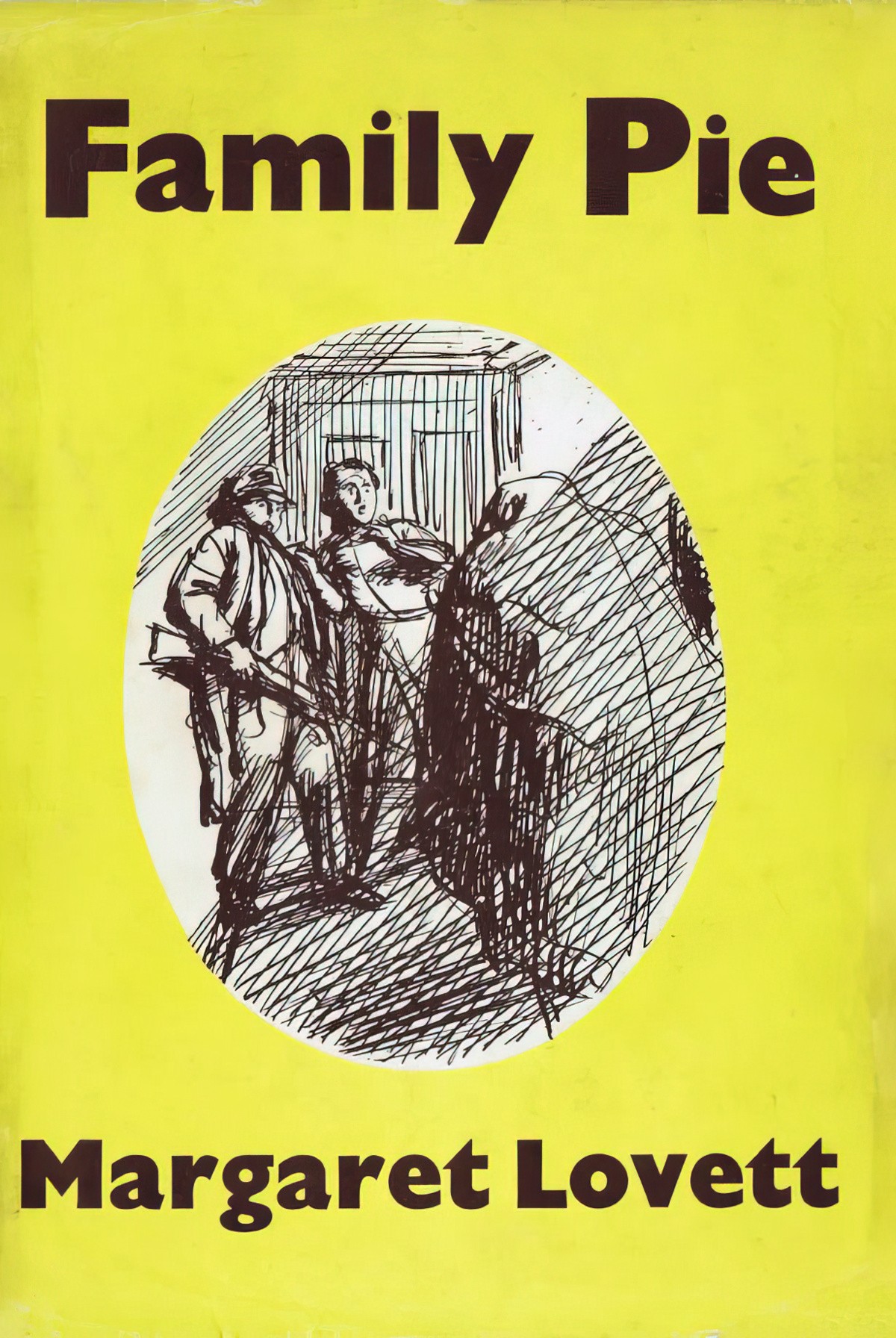
Family Pie by Margaret Lovett
Who were the occupants of the Big House and for what nefarious purpose did they use the place? That was the problem the likeable Carey children set themselves to solve during the school holidays spent at Port Carey. All had a finger in the pie — Jerry (seventeen), Talbot and Garth (twins), Alan (the youngest boy) and Dona (The youngest member of the family and the only girl, who likes to be treated as a boy). Jeremy (‘forever eight years old’ and part-time resident of the Big House) was co-opted by the gang and he takes a major part in a delightful and exciting family adventure story.
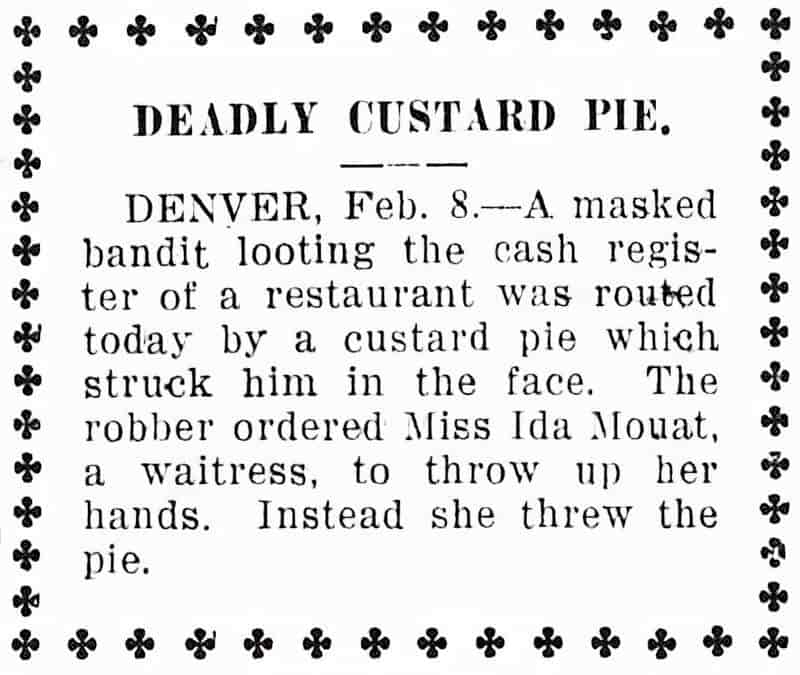
As American as Apple Pie? Although Pie came to America with the first English settlers, American pie focused on the sweet dessert varieties, and apple certainly earned its place at the top. But don’t forget pumpkin, pecan, cherry, custard… Petra Paredez of Petee’s Pie talks about the history of the many types and flavors from the popular to the forgotten from her book, Pie for Everyone.
American Pie History
MORE MEN AND THEIR CATS
